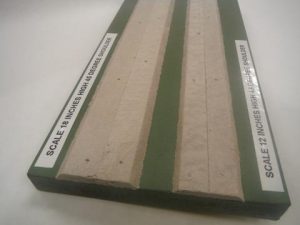If you’ve decided to build a permanent layout, a solid foundation for laying HO track will serve you well. There are many variations on how to build benchwork and what to use for your roadbed. Ultimately you will have to decide on how to proceed. I’ll assume you are familiar with hand and power tools needed for construction. Always use proper safety equipment when using power tools.
Building Benchwork
Your benchwork, the foundation of your layout, can be built from 1×3 or 1×4 lumber, easily found at any home improvement store. The problem with this type of lumber is it may not be as straight as you want. An alternative is to purchase AC-grade plywood and rip it to 3 ½ strips, which will be stronger, and guaranteed straighter.
Sub-roadbed must be supported every 16”, even if you are using ¾ plywood, which will sag if the spacing between the joists is larger.
Materials For Roadbed
For your sub-roadbed, I recommend that use good quality 3/4” plywood. This way when you lay your HO track it will remain level.
If you are going to have variations in elevation, you may want to use 2” extruded polystyrene insulation board, which you can get at any home improvement store. Cork can be used as your roadbed, since it will easily follow any variations in elevation. Make sure you use the proper adhesive to glue it to polystyrene insulation.

Alternatively, with a relatively level layout, you can cover the sub-roadbed with ½” Homasote sheets, which can be found at any home store or lumberyard. California Roadbed Company sells pre-cut strips of Homasote called “HomaBed” (www.homabed.com). Homabed is available for a large variety of scales and purposes.
For ultimate realism, your ballasted main line should be about 12 scale inches higher than your sidings. Use 1/4” Homabed for the main line, and 1/8” Homabed everywhere else to achieve this with HO scale because placing these on unbeveled 1/4” Homabed will lift the track a few more scale feed above the sub-roadbed.
Glue the Homasote and Homabed directly to the sub-roadbed. Homasote is excellent for sound deadening, and it accepts track spikes well. Homasote is stable in moist environments, your support structure is more likely to move around if the environment is moist.
Note that if you are using Homasote and planning on cutting it yourself, it is a very dusty process, and it will take a toll on your saw blade. You may want to have your lumberyard cut it for you.



Pingback: HO Track and Ballasting Guide | Tracking Inventory
Pingback: HO Track and Ballasting Guide | Sectional Living Room Furniture
Pingback: Uslifes – HO Track and Ballasting Guide
Pingback: Kenny Bendixen » Blog Archive » HO Track and Ballasting Guide
Pingback: HO Track and Ballasting Guide | Weather OK
Pingback: HO Track and Ballasting Guide | Portable Work Bench Store
Good article on laying HO track
Pingback: HO Track and Ballasting Guide | Time Tracking